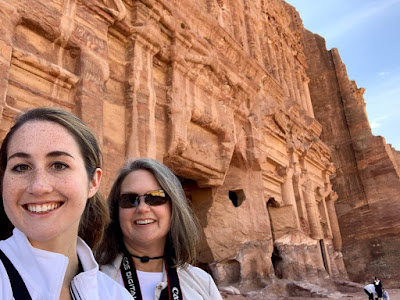I'll admit it up front... we got lost in Petra after a couple hours. We had a map that wasn't terribly detailed and the trails weren't well marked. That's our story and we're sticking to it. We might have spent more than the seven hours we did in Petra if we hadn't chanced upon a local Bedouin teenage girl who pointed us back to the main tourist track.
Petra was capital of the Nabataeans, flourishing from the 1st century BC though inhabited for centuries before that. Built along an overland trade route, it was well known for dealing in incense and spices. Petra was annexed by the Roman Empire in the 2nd century AD and we saw evidence of that in its architecture. A destructive earthquake hit Petra in 363 AD and destroyed much of the city. That, coupled with the change in trade routes and the Arab invasion several centuries later, eventually led to Petra becoming abandoned by all but the local Bedouin tribes by the 8th century.
In 1812, a Swiss explorer named Johannes Burckhardt "rediscovered" Petra, gaining fame in the west and attracting visitors. Petra is called the Rose City, and it will become apparent why through the pictures I took when we toured it. Carved from the native sandstone, erosion has taken its toll over time and yet Petra is still hauntingly beautiful.
Armed with a copy of the map above, tour guide Nidal gave us a lot of background information and details as we kicked off our trek into Petra.
Below is the famed Khazneh, or treasury, carved from the sandstone cliffs. It's believed that this was built as the mausoleum for King Aretas. I'll go into Aretas' biblical connection in my second post about Petra.
All along the most well traveled and main part of the tour with Nidal during our first 1.5 hrs at the site, we saw simple carvings and entrances...
... in addition to more elaborate ones.
As you can appreciate in the pic below, the natural rose-red sandstone was just gorgeous.
In the pictures above and below, you can get an idea of the scale of Petra. Despite the fact that we walked for ten miles, there was still a lot we just didn't have time to see.
The Nabataeans buried their dead in tombs with carved exteriors as you've seen in many of the photos.
It was interesting to note that although the outside of the tomb was typically quite ornate, there was only one interior with similar intricate carving.
Most of the interiors were disappointingly basic.
Our tour guide Nidal explained to us that this is how you differentiate from a burial tomb and a home - the burial has exterior carvings, but a dwelling does not. In addition to tombs and homes, Petra contains the remains of temples, a theater, churches, etc.
Polytheistic, the Nabataeans gods were never represented in full scale statuary like I've seen in Egypt and Italy. However, you can still see traces of the gods carved into doorways, nooks of temples and in niches.
Below is the theater, the only ancient theater in the world carved directly out of rock, with seating for about 4000 spectators.



















































No comments:
Post a Comment